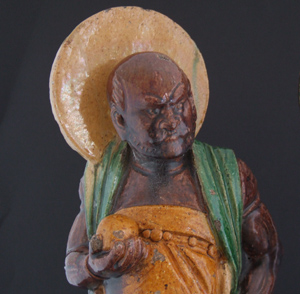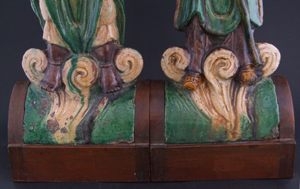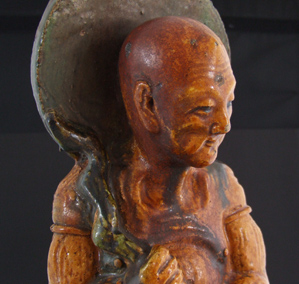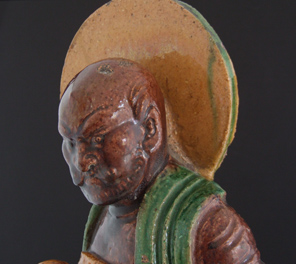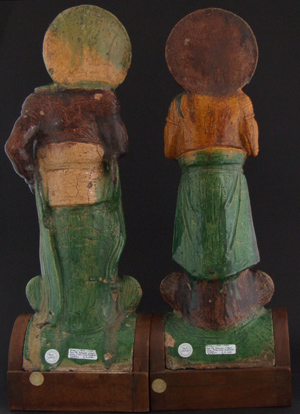
MING DYNASTY c.1500 – 1640 Ming Pottery
A Pair of Large Ming Dynasty Pottery Figurative Ridge Tile Representing Lohans Arhat, Ming Dynasty c.1500-1640. They are Depicted Standing on a Cloud, One Holds a Staff.
SOLD
- Condition
- The Lohan with the staff has some chipping to the edges of the base and some wear. The Lohan holding a pear has a large piece of his 'halo' restuck and the toes of his left foot restored. Minor glaze loss to the base and figure.
- Size
- Height , including later wood stands : 53 cm (21 inches)
- Provenance
- N/A
- Stock number
- 23977
Information
Ming Pottery Roof Tiles /
Liuli Wa :
According to traditional Chinese belief, roofs are platforms of communication between the words of the living and spirit realms. Consequently they were decorated to ward off evil and to act as a magnet for blessings and good fortune. Marco Polo was struck by the visual effect of these brightly coloured tiles, remarking while describing Khubilai Khan`s palace at Dadu (modern day Beijing) The roof is all ablaze with scarlet and green and blue and yellow and all the colours that are, so brilliant varnished that it glitters like crystal and the sparkle of it can be seen from far away. The Chinese had made ceramic tiles from early times but it was the Ming dynasty that saw the largest period of production, much of this was based in Shanxi Province at small family run kilns that passed down from generation to generation. Glazed tile-work is known in China as Liuli Wa, literally `roof-tile of glass`, a term dating back to the Tang Dynasty (618-906) although Tang tiles are now very rare. The soft earthenware used to make Ming tiles varies but often is uneven in its constitution with lots of grog. The tiles were mould made with a large amount of hand working, giving a completely hand-made look with lots of sharp detail and undercutting. They were lead glaze and low fired which means the glaze often runs. There were two basic colour schemes used Sancai (greens,yellows and browns) and the darker palette of Fahau (turquoise, blue and purple). The dating of Chinese glazed tiles, which were made over a long period of time with little change, is difficult. Knowing when the building they came from was build doesn`t help as tiles, exposed to the elements, needed replacing from time to time and so a building might contain tiles made over several centuries. However an approximate chronology can be understood, and with the study tile construction replacements can be identified as being different to the genuine Ming examples.
Lohan / Arhat :
A Lohan is the Chinese word used for a Buddhist Arhat, one who has followed the Eightfold Path and has achieved deliverance of this earthly existence. These holy Buddhist monks attained a form of sainthood through quite but rigorous religious study and good deeds. Most were loyal disciples of the Buddha who were called on to carry the faith abroad. Originally there were 16 Lohan but the Chinese added two during the Tang Dynasty (618-907), however there were as many as 500 lesser Lohan. They are often depicted as having Indian features and are rather indomitable-looking, usually they carry their own specific attribute. Lohans are well-known for their great wisdom, courage and supernatural power. Due to their abilities to ward off the evil, Lohans have became guardian angels of the Buddhist temples.
